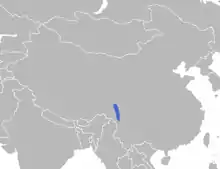Dwarf blue sheep
The dwarf blue sheep (Pseudois schaeferi) or dwarf bharal, is an endangered species of caprid found around Sichuan-Tibet in China. It inhabits low, arid, grassy slopes of the upper Yangtze gorge in Batang County of the Sichuan Province, and a small part of the Tibet Autonomous Region, where it is known by the local name rong-na.
| Dwarf blue sheep | |
|---|---|
 | |
| Scientific classification | |
| Kingdom: | Animalia |
| Phylum: | Chordata |
| Class: | Mammalia |
| Order: | Artiodactyla |
| Family: | Bovidae |
| Subfamily: | Caprinae |
| Genus: | Pseudois |
| Species: | P. schaeferi |
| Binomial name | |
| Pseudois schaeferi Haltenorth, 1963 | |
 | |
| Dwarf blue sheep range | |
Taxonomy
Originally given subspecific status to the bharal (Pseudois nauyar), morphological research conducted in the 1970s led it to be considered a distinct species. However, recent molecular analysis has shown the difference between the two species is slight, and suggests it should be treated as a subspecies of the bharal, as the IUCN does.
Description
The dwarf blue sheep differs from the bharal primarily in size, with adult males weighing around 35 kg, half as much as the bharal. Less sexual dimorphism occurs in this species, and females of the two species are very similar. Its coat is a steely grey with a silvery sheen, with darker general colouration than the bharal, and the horns of the male are smaller, thinner and more upright, with no inward curl.
Conservation
In 2000, there were estimated 200 individuals of dwarf blue sheep alive. The species is hunted, and in their limited range cannot escape from humans. Although a reserve of 142.4 square km was set up around Zhubalong in 1995, human activities continue.
Habitat
It lives mostly on rocky slopes generally at very high altitudes, such as between 8500 and 9500 feet above sea level. The dwarf blue lives in dry areas, and valleys in the mountains.
Diet and behaviour
The dwarf blue sheeep sustains mostly on grasses but also other plants such as club moss. It performs alternative activities through the day, going from sleeping, to grazing, and back to sleeping over the course of the day. It usually inhabits very steep grassy slopes. P. schaeferi live in groups of about six; however in the past, when they were more plentiful, they lived in family groups of 10-30 individuals.
Breeding
The dwarf blue sheep reaches maturity about 1–2 years old, although the males do not normally mate until they reach peak size, about 7 years old.
References
- Huffman B, Harris R (2014). "Pseudois nayaur ssp. schaeferi". IUCN Red List of Threatened Species. 2014. Retrieved 17 August 2020.CS1 maint: ref=harv (link) Database entry includes a brief justification of why this species is of endangered.
